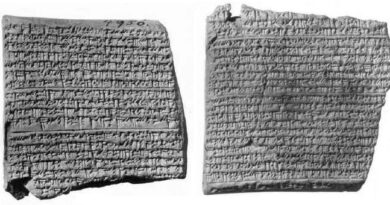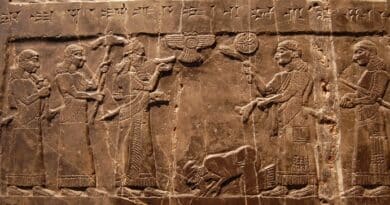The Earliest Civilization and the Bible
According to the first chapters of the Bible, the earliest human civilization on earth began in and around Mesopotamia in the Near East. If this is correct, we should expect to find in this area traces of the earliest human settlements and villages, the earliest traces of stock-farming and agriculture, the earliest metallurgy and handicraft, the earliest cities, states, trade and writing. How does this tally with the findings of modern archaeology?
A. THE GARDEN OF EDEN
According to the Bible the earliest dwelling-place of the first human couple was a “garden” located in an area called ”Eden”. Scholars generally dismiss this story as a legend or myth. Dr. E. A. Speiser, however, who before his death in 1965 was Chairman of the Department of Oriental Studies at the University of Pennsylvania in Philadelphia, in a careful examination of the story noted that at least its physical background is authentic. In an article originally published in 1959 he stated:
“Although the Paradise of the Bible was manifestly a place of mystery, its physical setting cannot be dismissed offhand as sheer imagination. To the writer of the account in Gen 2:8ff., in any case, and to his ultimate source or sources, the Garden of Eden was obviously a reality.” – E. A. Speiser, ”The Rivers of Paradise,” reprinted in R. S. Hess & D. T. Tsumura (eds.), ”I Studied Inscriptions from Before the Flood” (Winona Lake: Eisenbrauns, 1994), p. 175.
The geographical details given by the Biblical writer helps to at least approximately identify the location of the site:
“Now the LORD God had planted a garden in the east, in Eden; and there he put the man he had formed. … A river watering the garden flowed from Eden; from there it was separated into four headwaters. The name of the first is the Pishon; it winds through the entire land of Havilah, where there is gold. (The gold of that land is good; aromatic resin and onyx are also there.) The name of the second river is the Gihon; it winds through the entire land of Cush. The name of the third river is the Tigris; it runs along the east side of Asshur. And the fourth river is the Euphrates.” – Genesis 2:8, 10-14, NIV.
The names of the last two rivers are easily recognizable as the two great rivers flowing toward southeast from eastern Turkey in the north through the modern country of Iraq. About 180 kilometers north of the Persian Gulf the two rivers join into one river, Shatt al-A’rab, which empties its waters into the Persian Gulf. What about the other two rivers, Pishon and Gihon?
1. Gen. 2:10: The four ”heads” or ”headwaters”
Before attempting to identify the Pishon and Gihon rivers, it must be determined whether the writer means that the four ”headwaters” started out from a common source somewhere in eastern Turkey, or whether they converged into a common river channel in the south.
Normally, a river does not break up on its way downstream from its source into several rivers that reach the sea separately, although such a break up may occur in a delta area near the sea, as in the Egyptian Nile delta. Rather, a river is joined during its downstream course by other rivers or tributaries to form one common river channel that finally empties its waters into the sea. This is clearly the case with the rivers of Euphrates and Tigris today. That Eden, where the four headwaters or rivers converged was located in the south also has linguistic support, as Dr. Speiser argues:
“It would seem to follow, then, that the ’four heads’ of which the text speaks (v. 10) are meant to be viewed upstream rather than down, something very few authorities appear to have realized. Yet both Akkadian and Hebrew usage support such a view. Thus Akk. ina reš Uqnê stands for ’on the upper Kerkha.’ And A. Ehrlich has pointed out that the Hebrew term for the lower course of a stream isqatsê [’mouth’] (cf. Josh 15:5, 18:19); hence roš [”head”] must refer to the opposite end, the upper course or headstream.” – Speiser (1994), pp. 178-179.
Thus Speiser, on page 20 of his commentary on Genesis (The Anchor Bible: Doubleday, 1962), concludes that ”the term ’heads’ can have nothing to do with streams into which the river breaks up after it leaves Eden, but designates instead four separate branches which have merged within Eden.”
Very interestingly, the ancient Sumerians, too, who inhabited southern Mesopotamia, located the original paradise, which they called Dilmun, at the mouth of the rivers, in an unknown territory to the east of the Sumerian cities. – Theresa Howard-Carter, ”The Tangible Evidence for the Earliest Dilmun,”, Journal of Cuneiform Studies, Vol. 33 (1981), pp. 217-220.
All of this means that the area where the four rivers converged should be sought in the south. We have already seen that the Euphrates and Tigris rivers join into one river not very far from the Persian Gulf. If the region of Eden embraced or adjoined this area, the other two rivers, Gihon and Pishon, also merged with the other two somewhere in the same general region.
2. Gihon, the river of Cush
The “land of Cush”, through which the Gihon river is stated to have wound, is most often used in the Bible of the region south of Egypt, i.e., Nubia or Ethiopia. However, in ancient times there was also another ”land of Cush,” which lay to the east of Mesopotamia in what is today western Iran. Speiser explains:
“The source of most of our geographical troubles with the biblical Paradise is the mention of a land called Cush in Gen 2:13. Normally, the Bible understands by that term the region of the Upper Nile, cuneiform Kus/šu, Kas/ši, Eg[yptian] K’š. But there was also another, and wholly unrelated, Cush; the Nimrod fragment (Gen 10:8-12) connects this homonym unmistakenly with Mesopotamia, by assigning it to the father of the hero who is said to have founded a number of Babylonian and Assyrian capitals. This particular Cush, then, is the eponym of the Kassites, Akk. Kaššû; its Nuzi form Kuššu- and its Greek derivativeKossaîoi, actually contain the same vowel as the biblical name.” – Speiser (1994), pp. 176-177.
Much later, these Kassites conquered Babylon and ruled Babylonia c. 1500-1150 BCE.
Today, two major rivers flow from the Iranian mountains in the east down to the southern part of the Mesopotamian flood-plain, viz., Kerkha and Karun, the latter joining Shatt al-A´rab about 50 kilometers north of the Persian Gulf, while Kerkha, ancient Choaspes, flows past the site of ancient Susa down to the marshes north of Shatt al-A’rab. The Samaritan version actually ”renders Gihon, the name of the river of Cush, by ’Asqop, evidently the Choaspes, modern Kerkha.” (Speiser, 1994, p. 177) Owing to variations of the river flows, changes of the sea level prior to the third millennium BCE, and the marshy flood-plain in southern Iraq, the lower courses of these rivers have changed considerably since ancient times. It is even possible that the two adjacent rivers amalgamated into one river before reaching the Gulf area. If one of them, or perhaps both jointly, is the Gihon River, as seems likely, where is Pishon?
3. Pishon, the river of Havilah
According to Genesis 2:11-12, Pishon “winds through the entire land of Havilah, where there is gold. (The gold of that land is good; aromatic resin and onyx are also there.)” Speiser first considered either Kerkha or Karun as possible candidates. But as the land of Havilah is most commonly connected with the Arabian Peninsula (Gen. 10:26-29; 25:18; 1 Chron. 1:20-23), he also suggested that one of the now dry wadis (dry riverbeds) that slope down from the south, could be identified with the Pishon river, adding: ”It remains to be shown, however, that any of the present wadis was sufficiently active during the period in question to constitute a sizable and perennial river.” – Speiser (1994), p. 182.
That a ”sizable and perennial river” once did exist in this area that in every respect meets the description of the Pishon river has, in fact, been clearly demonstrated in later years by modern climatological research and satellite studies. James A. Sauer, former curator of the Harvard Semitic Museum’s archaeological collections and up to his death in the late 1990’s a leading excavator of various sites on the Arabian Peninsula, has summarized these findings in his article, ”The River Runs Dry. Creation Story Preserves Historical Memory,” published in the Biblical Archaeology Review, Vol. 22:4, July/August 1996, pp. 52-57, 64.
James Sauer starts by saying that he speaks ”as a former skeptic.” He had long doubted that archaeology could uncover evidence of the earliest Biblical stories, having previously written numerous papers in which he had criticized the optimism of W. F. Albright and many of his students. ”Now I am recanting,” he says. ”My current work on climate change had led me to conclude that Albright and his students were clearly correct to look for connections between the archaeological evidence and early Biblical traditions.” (Sauer, p. 52)
Contrary to the previously prevailing view, recent research has shown that dramatic climatic changes have occurred within historical times in the Near East and elsewhere. According to carbon 14 datings (that are very rough and uncertain at this early period), a global wet phase began in about 7500 BCE that lasted until about 3500 BCE. The warm wet humid climate during this period encouraged the growth of subtropical vegetation in the areas around the Persian Gulf. In southern Saudi Arabia ancient lakes existed in what is today the largest sand desert in the world, and further north a river originating in the Hijaz Mountains in the west run toward northeast across the whole Arabian Peninsula into the head of the Persian Gulf.
This large river, which in places was 3 miles wide, was discovered in the early 1990’s by Boston University scientist Farouk El-Baz while studying a satellite photo of central Arabia. Much of the river channel is today concealed by sand dunes. It has been named the ”Kuwait River”, as it reached the Persian Gulf via the now dried riverbed called Wadi Al-Batin that runs along the northern border of Kuwait. In about 3500 BCE the climate suddenly changed, and a drier period followed that peaked in the period 2350-2000 BCE, causing the ”Kuwait River” to dry out. (This climatic disaster also brought the Akkadian empire to an end. See the Science magazine, Vol. 261, 20 August 1993, p. 985: ”How the Akkadian Empire Was Hung Out to Dry”, and ibid., pages 995-1004: ”The Genesis and Collapse of Third Millenium North Mesopotamian Civilization.”)
Sauer concludes that the “Kuwait River” most probably was the Pishon River. Citing Genesis 2:11-12, he gives the following interesting comments:
”Although the meaning of some of the details in this passage is uncertain, it does seem to describe a river flowing into the head of the Persian Gulf from the low mountains of western Arabia, the path followed by the recently discovered Kuwait River. An important key is the Biblical phrase ’the gold of that land is good.’ Only one place in Arabia has such a deposit—the famous site of Madh edh-Dhahab, the ‘Cradle of Gold.’ This ancient and modern gold mining site is located about 125 miles south of Medina, near the headwaters of the Kuwait River.
The Biblical text also mentions bdellium and onyx. Aromatic resins (bdellium) are known in Yemen to the southwest, and, although they are not thought to have been produced in the vicinity of Medina, they could easily have been brought there. Semiprecious stones such as alabaster also come from these areas, but it is uncertain whether other precious stones, such as onyx, do.” (p. 64)
Sauer adds:
“In any event, no other river would seem to fit the Biblical description. I am therefore inclined to think that the Kuwait River could be the Pishon of the Bible. If so, it implies extraordinarily memory on the part of the Biblical authors, since the river dried up sometime between 3500 and 2000 B.C.E.”
4. Under the Persian Gulf
Most likely, the region of Eden included parts of which is now the Persian Gulf. That the Persian Gulf now covers areas that once have been inhabited has been known for a long time. Referring to an article published in 1957, Speiser says:
“Significantly enough, aerial photographs still show traces of ancient cultivation under the present northwest reaches of the Persian Gulf.” – Speiser (1994), p. 180 + note 26 (P. Buringh, “Living Conditions in the Lower Mesopotamian Plain in Ancient Times,” Sumer 13, 1957, p. 36).
The Persian Gulf is shallow, only about 25 meters deep on the average, the deepest place being 102 meters. At the end of the last Ice Age, now usually supposed to have occurred some time between 12000 and 9000 BCE, the sea level was more than 100 meters, perhaps up to 150 meters below the present level, meaning that the Persian Gulf back then must have been an entirely dry basin. This was confirmed by the researches in the Gulf area performed in the 1960’s by the German exploration ship Meteor. It was found that the Gulf had been an 800 kilometers long valley, along which the extended Shatt al-A’rab river carved its course all the way to the Straits of Hormuz and debouched directly into the Gulf of Oman. – Theresa Howard-Carter,” The Tangible Evidence for the Earliest Dilmun,” Journal of Cuneiform Studies, Vol. 33 (1981), p. 213.
In recent years, evidence has been accumulating to show that the end of the last ice age was a surprisingly sudden event. Professor Richard A. Muller and Dr. Gordon J. MacDonald, two leading experts on the Ice Ages, explain:
“The abruptness of the termination is startling. Agriculture, and all of our civilization, developed since this termination. The enormous glacier, several kilometers thick, covering much of North America and Eurasia, rapidly melted. Only small parts of this glacier survived in Greenland and Antarctica, where they exist to this day. The melting caused a series of worldwide floods unlike anything previously experienced by Homo sapiens. … The flood dumped enough water into the oceans to cause the average sea level to rise 110 meters, enough to cover the coastal areas … The water from melting ice probably flooded down over land in pulses, as ice-dammed lakes formed and then catastrophically released their water. These floods left many records, including remnant puddles now known as the Great Lakes, and possibly gave rise to legends that persisted for many years.” – Richard A. Muller & Gordon J. MacDonald, Ice Ages and Astronomical Causes (Berlin-Heidelberg-New York: Springer-Verlag, 2000), page 4.
It is believed that the earliest inhabitants in Mesopotamia originally lived in this valley that is now the Persian Gulf. The examination of drowned cost lines and sea plateaus shows that the Gulf was filled from the Indian Ocean in the south in carefully-measured stages, forcing the inhabitants to retreat northwards to higher grounds. About 5500 BCE most of the Gulf basin was evidently filled, although the sea level was still 17 meters lower than that of today. (W. Nuetzel, ”On the Geographical Position of as yet Unexplored Early Mesopotamian Cultures”, Journal of the American Oriental Society [JAOS], Vol. 99, 1979, pp.288-296; also J. Zarins, ”The Early Settlements of Southern Mesopotamia,” JAOS, Vol. 112:1, 1992, pp. 55-77.) This was the time of the Ubaid culture. During this whole period the climate was temperate and pleasant. Then, in about 3500 BCE, an enormous flood catastrophe occurred in the area that suddenly brought an end to the Ubaid civilization. Most probably, this event is that reflected in the Mesopotamian and Biblical Flood stories. – Howard-Carter, op. cit., pp. 214-216, 220-222.
Before this catastrophe, however, the civilization of man had spread all over the Near East, and also to other parts of the world. The earliest traces have been found in Mesopotamia, western Iran, Asia Minor, Syria and Palestine.



